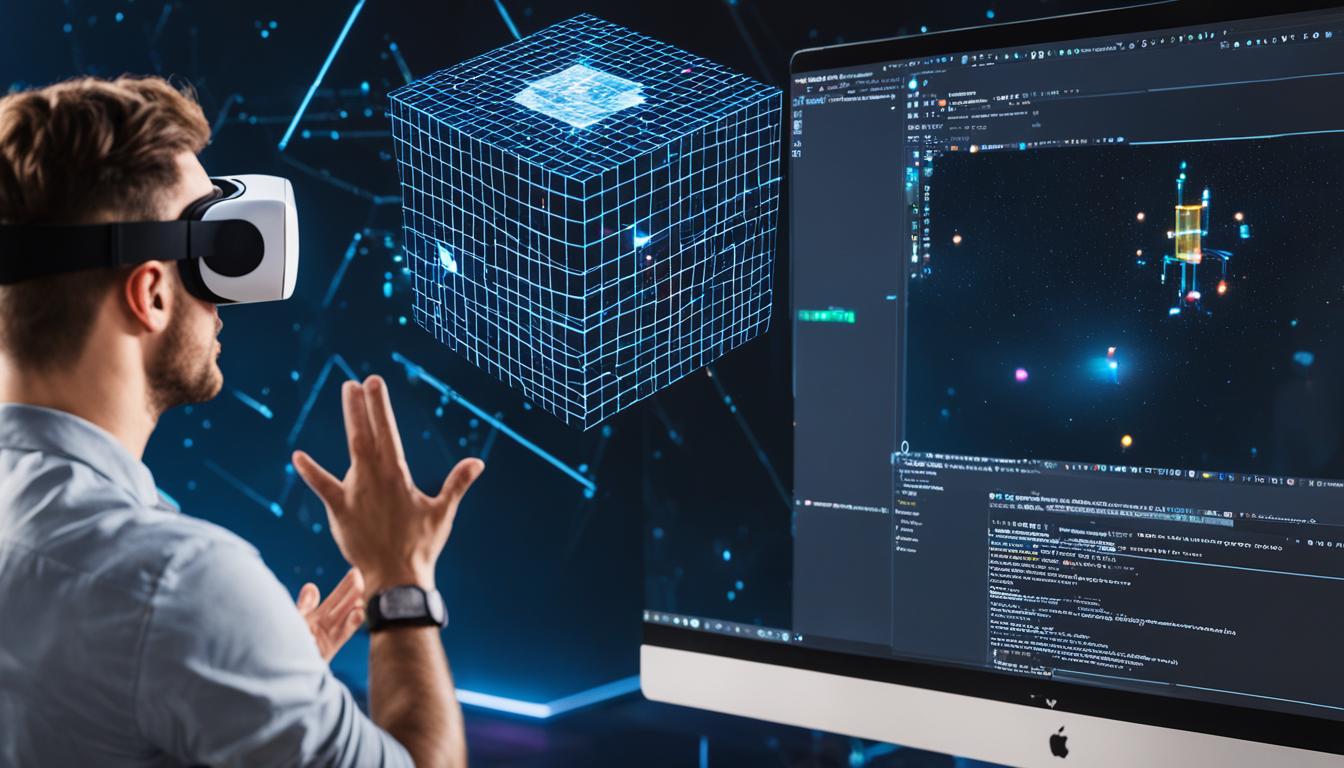Welcome to our augmented reality Unity guide! This tutorial will walk you through creating captivating augmented reality experiences using Unity.
Whether you are a beginner or have some experience with Unity, this guide will equip you with the knowledge and skills to develop your own AR projects.
Augmented reality has gained immense popularity recently, opening up new opportunities for interactive and immersive applications. By combining virtual elements with the real world, AR creates a new level of user engagement and excitement.
With Unity as your development platform, you can access a comprehensive suite of tools and resources tailored specifically for AR development. Unity’s powerful features and intuitive interface make it ideal for creating stunning AR experiences.
Now, let’s dive into the basics of augmented reality development with Unity. We will guide you through each step, providing clear instructions and examples to help you understand and implement critical concepts.
Contents
- 1 Setting up Unity for Augmented Reality
- 2 Building an AR World with Unity
- 3 Interacting with AR Objects in Unity
- 4 Conclusion
- 5 FAQ
- 5.1 How do I do augmented reality with Unity?
- 5.2 How do I set up Unity for augmented reality development?
- 5.3 How do I build an augmented reality world using Unity?
- 5.4 How do I interact with AR objects in Unity?
- 5.5 How can Unity Mars enhance my AR experiences?
- 5.6 What is the Unity AR template, and how can it help me?
- 6 Source Links
Key Takeaways
- Unity offers a user-friendly platform for developing augmented reality experiences.
- Augmented reality combines virtual elements with the real world, creating interactive and immersive applications.
- This guide will teach you how to create your AR projects using Unity.
- Unity provides various tools and resources specifically designed for AR development.
- Stay tuned for the following sections: Unity setup, building AR worlds, interacting with AR objects, and enhancing your AR experiences with Unity Mars.
Setting up Unity for Augmented Reality
This section will guide you through setting up Unity for augmented reality development. By following the steps below, you will have a fully equipped Unity environment to start creating your own AR applications.
Step 1: Downloading Unity
You must download the Unity software to get started with Unity for augmented reality. Follow these simple steps:
- Go to the official Unity website at unity.com.
- Select the Get Started button on the homepage.
- Choose the version of Unity that is compatible with your operating system.
- Click on the Download Unity Hub button to start the download.
- Once the download is complete, run the installer and follow the installation instructions.
Now that you have Unity installed let’s move on to the next step.
Also read: What Kind of Data Does Augmented Reality Use?
Step 2: Installing AR Plugins and Tools
You must install the necessary plugins and tools to enable augmented reality development in Unity. These plugins provide the functionality and features required for AR experiences. Follow these steps to install the AR plugins and tools:
- Launch Unity Hub on your computer.
- Click on the Installs tab on the left-hand side.
- Click on the Add button to add a new Unity version.
- Select the desired Unity version from the list.
- Check the Android Build Support and iOS Build Support options, as they are essential for AR development.
- Click the Next button and follow the on-screen instructions to complete the installation.
Now that you have installed Unity and the necessary plugins, you can start your augmented reality journey.
“Setting up Unity for augmented reality is the first step towards creating immersive AR experiences. Make sure you have the latest version of Unity and the required AR plugins to unleash your creativity.”
| Unity Version | Operating System | AR Plugins and Tools |
|---|---|---|
| Unity 2020.3 | Windows 10 | Vuforia, ARFoundation |
| Unity 2020.3 | macOS Big Sur | ARKit, ARCore |
| Unity 2019.4 | Windows 7 | Vuforia, ARFoundation |
Building an AR World with Unity
Ready to bring your imagination to life in the world of augmented reality? With Unity, you can create stunning AR experiences that captivate your audience. This section will guide you through building an AR world using Unity.
You’ll need to understand the essential components and scripts that make up an AR scene to get started. Let’s take a look at what you’ll be working with:
- AR Session: This component manages the overall AR experience and provides the necessary tracking capabilities.
- AR Session Origin: This component is the starting point for placing virtual objects in the real world.
- AR Session Manager: This component handles the lifecycle of the AR session and provides essential configuration options.
Also read: Upload Pictures to Augmented Reality on iPad?
Adding these components to your Unity project gives you a solid foundation for creating your AR world. But what can you do with Unity and AR? Let’s explore some exciting examples:
“The possibilities are endless when it comes to creating augmented reality games with Unity. Imagine transforming your living room into a virtual battlefield or overlaying magical creatures in your local park. Unity empowers you to unleash your creativity and build immersive AR experiences.”
With Unity, you can bring your wildest ideas to life and create immersive AR games that blur the line between the real and virtual worlds. Whether you’re a novice developer or an experienced professional, Unity offers a range of resources and support to help you succeed.
Ready to dive into the world of augmented reality? Let’s begin your journey to create unique AR experiences using Unity.

Interacting with AR Objects in Unity
This section will explore how to seamlessly integrate Unity with augmented reality (AR) technology, allowing you to create immersive and interactive AR experiences.
It’s essential to understand how to interact with AR objects within the Unity environment to maximize the potential of your AR applications.
Object Placement
When building AR experiences in Unity, object placement plays a crucial role in creating a realistic and engaging environment. You can position AR objects accurately by leveraging Unity’s AR Foundation package, which provides a unified API for AR platforms.
“Unity’s AR Foundation package simplifies object placement in AR by providing consistent tracking and anchoring of virtual objects in the real world. This ensures that your AR objects align seamlessly with the physical environment, enhancing the user experience.”
Following Unity’s best practices for object placement, you can create AR applications that seamlessly blend virtual and real-world elements, providing users with a captivating and immersive experience.
Gesture Recognition
Another essential aspect of interacting with AR objects in Unity is gesture recognition. By recognizing gestures, your AR applications can intuitively enable users to interact with virtual objects.
Unity offers various approaches to gesture recognition, such as using touch and swipe gestures on mobile devices or hand tracking on AR-enabled devices. You can leverage Unity’s input and event systems to capture and process different gestures, providing your users with a seamless and natural interaction.
User Interaction
Engaging user interaction is critical to creating memorable AR experiences. Unity offers multiple ways to enable user interaction with AR objects, including touch, voice commands, and gaze-based interaction.
By incorporating intuitive controls and leveraging Unity’s user interface (UI) components, you can create interactive elements that allow users to manipulate virtual objects, trigger animations, or navigate AR scenes.
Unity’s AR Foundation package provides the tools and components to implement user interaction seamlessly, making it easier for developers to create immersive and user-friendly AR applications.
Best Practices for Unity AR Integration
Integrating Unity with AR technology requires careful consideration of best practices to ensure optimal performance and user experience. Here are some essential Unity AR best practices to keep in mind:
- Optimize your AR applications for performance by minimizing processing and rendering overhead.
- Design intuitive user interfaces (UI) that guide users smoothly through the AR experience.
- Test your AR applications on different devices and environments to ensure compatibility and consistency.
- Implement error handling and feedback mechanisms to provide users with clear instructions if tracking or interactions encounter issues.
- Regularly update your Unity version and AR libraries to benefit from the latest improvements and features.
By following these best practices, you can ensure that your Unity AR integration is seamless, robust, and delivers exceptional user experiences.

| Unity Mars Features | Benefits |
|---|---|
| Plain-language authoring approach | Simplifies AR development for all skill levels |
| Proxy-based workflow | Enables quick prototyping and iteration |
| In-editor simulation | Allows for real-time testing and refinement |
Conclusion
Congratulations on reaching the end of our guide to doing augmented reality with Unity! Throughout this article, we have provided a comprehensive step-by-step tutorial on developing augmented reality experiences using Unity.
Following the instructions and examples in each section, you have gained the knowledge and skills to start creating your AR applications.
Unity is a powerful platform for AR development, offering a wide range of tools, plugins, and resources to help bring your ideas to life. Whether you want to build augmented reality games, interactive experiences, or industrial applications, Unity provides a user-friendly and versatile environment for your projects.
By setting up Unity for augmented reality, building AR worlds, interacting with AR objects, and exploring advanced features like Unity Mars, you have learned the ins and outs of Unity AR development.
We hope this guide inspired you to explore and experiment with different AR concepts and unleash your creativity in augmented reality.
FAQ
How do I do augmented reality with Unity?
You can follow our step-by-step guide in this article to do augmented reality with Unity. We will cover the basics of increased reality development with Unity and provide a tutorial to help you get started.
How do I set up Unity for augmented reality development?
To set up Unity for augmented reality development, you need to download and install Unity. Additionally, you will need to install the necessary plugins and tools for AR development. Our guide in this article will walk you through the entire setup process.
How do I build an augmented reality world using Unity?
To build an AR world using Unity, you must understand the components and scripts required to create an AR scene. In our guide, we will explain these components, such as the AR session, AR session origin, and AR session manager. We will also provide examples of AR projects you can create with Unity.
How do I interact with AR objects in Unity?
Interacting with AR objects in Unity involves various aspects, such as object placement, gesture recognition, and user interaction. Our guide will cover these topics and provide best practices for integrating Unity with AR technology.
How can Unity Mars enhance my AR experiences?
Unity Mars is a purpose-built authoring tool specifically designed for creating AR applications. It provides a plain-language authoring approach, a proxy-based workflow, and in-editor simulation to enhance AR experiences. We will introduce you to Unity Mars and explain how it can streamline your AR development process.
What is the Unity AR template, and how can it help me?
The Unity AR template is a starting point for AR development in Unity. It provides a foundation and pre-built components that you can use in your projects. We will discuss the Unity AR template in our guide, highlighting its benefits and how it can be helpful in your AR development process.




